
Rio de Janeiro’s beaches, renowned globally for their unparalleled beauty, stand out as some of the most stunning in the world, as the city captures a unique essence that distinguishes it from other summer destinations! Whether it’s the enchanting atmosphere or the warm hospitality of the Brazilian people, there’s an irresistible allure that makes the beaches of Rio de Janeiro incredibly inviting.
Join us as we delve into the charm and captivating experiences that await along the sun-kissed shores of Rio!
Does Rio de Janeiro have nice beaches?
With pristine sands, crystal-clear waters, and a captivating atmosphere, Rio’s beaches stand out as some of the most stunning in the world. Beyond the natural beauty, the warm hospitality of the Brazilian people adds an extra layer of charm, making the beaches incredibly inviting. Whether you’re looking to swim, surf, or simply relax, Rio de Janeiro’s beaches offer a diverse and unforgettable experience for every beach enthusiast.
Copacabana
Copacabana, one of Rio de Janeiro’s iconic beaches, is situated along a 4-kilometer stretch of shoreline, making it one of the most famous urban beaches globally. With its crescent-shaped design, Copacabana is flanked by a bustling cityscape on one side and the Atlantic Ocean on the other. The beach is lined with a mosaic boardwalk known as the “Calçadão,” featuring intricate designs that mirror the waves of the sea.
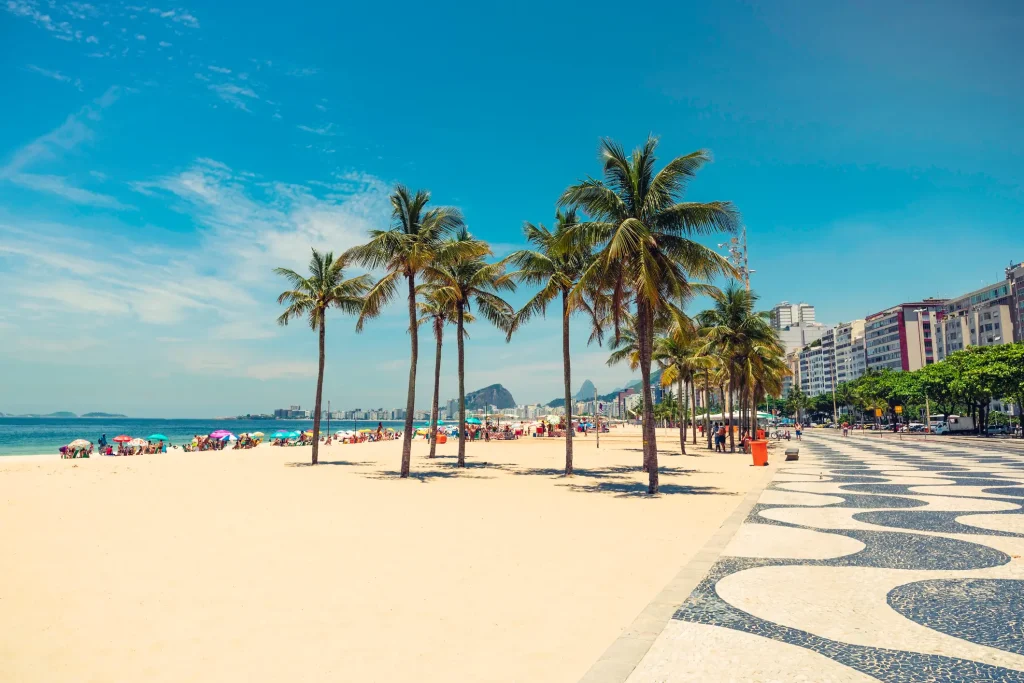
Copacabana Beach is not only a scenic destination but also a hub of activity. Its wide sandy expanse accommodates various beach sports, from beach volleyball to soccer, attracting both locals and tourists. Numerous beachside kiosks offer refreshments, snacks, and local delicacies, providing a vibrant atmosphere day and night.
The Copacabana Fort, situated at one end of the beach, adds a historical touch. Built in the early 20th century, the fort now houses a military museum, allowing visitors to explore a bit of Rio’s past amid stunning coastal views.
In addition to its recreational and historical aspects, Copacabana hosts a range of events, including the world-famous New Year’s Eve celebrations and beachside concerts.
Ipanema
Another iconic beach in Rio de Janeiro, Ipanema is renowned for its distinct neighborhoods, diverse culture, and vibrant atmosphere. Situated between Copacabana and Leblon beaches, Ipanema stretches for approximately 2 kilometers along the city’s coastline.
The beach is divided into different segments, known as “postos,” each catering to a specific crowd or activity. For instance, Posto 9 is a hotspot for the younger, trendier crowd, while Posto 7 is often favored by families. The beachfront promenade, bordered by lively kiosks and shops, offers an array of snacks, refreshing drinks, and local crafts.
Ipanema is also famed for its iconic mosaic boardwalk, which lines the beach and is a popular spot for strolling or cycling. The neighborhood surrounding the beach is equally captivating, featuring upscale boutiques, trendy restaurants, and a lively nightlife.
Praia Vermelha
Located in the neighborhood of Urca, Praia Vermelha, or “Red Beach” in English, is a notable beach in Rio de Janeiro. Unlike some of the more bustling beaches in the city, Praia Vermelha offers a relatively serene atmosphere, making it an ideal destination for those seeking a quieter beach experience.
One notable feature of Praia Vermelha is its proximity to the iconic Sugarloaf Mountain (Pão de Açúcar). The stunning views of the mountain from the beach create a picturesque backdrop, making it a popular spot for both locals and tourists alike.
While not as bustling as Copacabana or Ipanema, Praia Vermelha has its own charm, with a selection of beachside kiosks offering refreshments. Additionally, the beach serves as a starting point for the trail leading to the top of Sugarloaf Mountain, attracting adventure seekers and nature enthusiasts.
Leblon
Leblon, one of Rio de Janeiro’s most prestigious neighborhoods, boasts a beach that is a favorite among locals and visitors alike. Stretching approximately 1.3 kilometers along the coastline, Leblon Beach is known for its upscale ambiance and clean, well-maintained surroundings.
The beach is separated from its more famous neighbor, Ipanema, by the Vidigal Hill. This geographical feature not only contributes to Leblon’s exclusive atmosphere but also offers stunning panoramic views of the surrounding landscape. The wide sandy shore provides ample space for beachgoers to enjoy various activities, from beach volleyball to paddleboarding.
Leblon’s waterfront is lined with kiosks offering refreshments, snacks, and beachside service, providing a convenient and enjoyable experience for visitors. The neighborhood itself is characterized by high-end real estate, upscale shopping, and fine dining, attracting a more affluent crowd.
Barra da Tijuca
Barra da Tijuca, commonly referred to as Barra, is one of Rio de Janeiro’s largest and most prominent beach neighborhoods. Stretching for approximately 18 kilometers along the city’s southwest coast, it boasts a vast expanse of white sandy beaches and is known for its spacious and less crowded ambiance compared to some other popular Rio beaches.
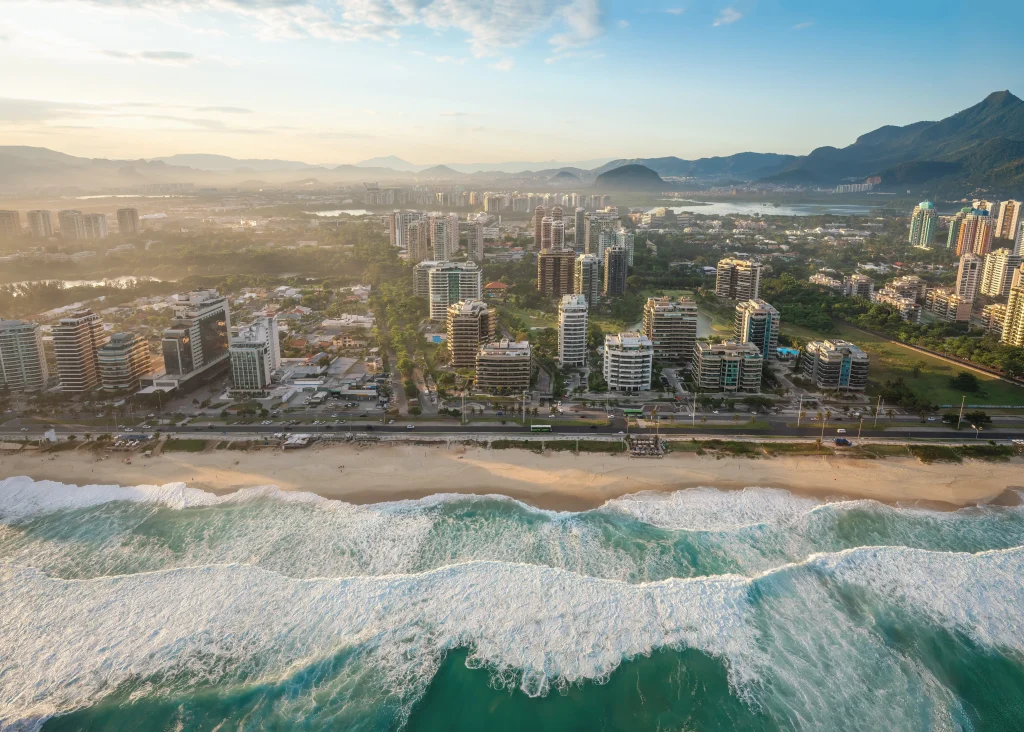
The beachfront at Barra da Tijuca offers excellent conditions for water sports such as surfing and kiteboarding, thanks to its consistent waves. The neighborhood itself is a mix of residential and commercial areas, featuring shopping malls, restaurants, and a thriving nightlife.
One notable landmark is the Barra Olympic Park, constructed for the 2016 Summer Olympics, which adds a modern touch to the area. Additionally, the Marapendi Lagoon and the ecological reserve of Marapendi are nearby, providing opportunities for outdoor activities.
Which beach is better, Copacabana or Ipanema?
When comparing Copacabana and Ipanema, it’s essential to consider individual preferences and the specific experience you seek! If you prefer a bustling and lively atmosphere with a long stretch of beach, Copacabana might be your choice. Now, if you lean towards a more sophisticated and trendy environment, Ipanema could be the ideal fit. Both beaches have their unique charm, so the “better” option ultimately depends on your personal preferences and the experience you’re looking for.
Which beaches in Rio de Janeiro are best for surfing?
If you’re an avid surfer or looking to catch some waves during your visit, Rio has a variety of beaches catering to different skill levels – each beach has its own characteristics that influence wave quality and suitability for surfing.
Arpoador
Nestled between the iconic beaches of Ipanema and Copacabana, Arpoador is a popular destination for surf enthusiasts in Rio de Janeiro. Known for its consistent waves and reliable surf conditions, Arpoador attracts both seasoned surfers and those looking to catch their first wave. The beach faces the open sea, allowing for a more consistent swell compared to other beaches in the area.
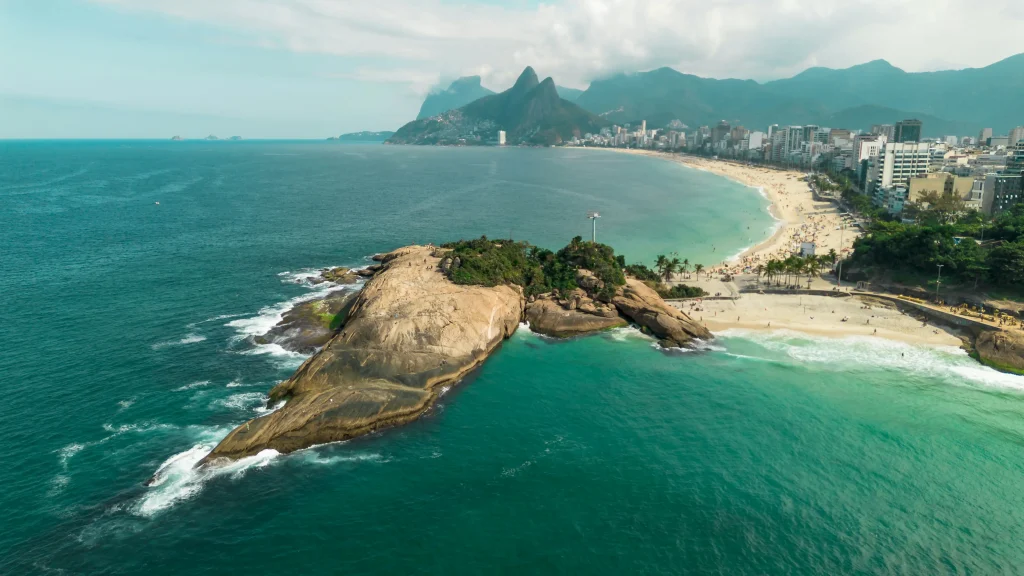
One of the key features that make Arpoador ideal for surfing is its rock formation extending into the ocean. This underwater rock shelf plays a crucial role in shaping the waves, creating a reliable break that surfers can count on. The waves here are typically well-suited for various skill levels, offering both beginners and experienced surfers an opportunity to enjoy the sport.
Additionally, the surf culture at Arpoador adds to its appeal. Surfers from different parts of the world gather here to share the waves and the vibrant energy of the ocean. The beach’s accessibility and central location make it a convenient choice for locals and visitors alike who are seeking quality surf conditions.
Joatinga
Located along the southern coast of Rio de Janeiro, Joatinga Beach stands out as a haven for surfing enthusiasts. The beach is characterized by a rocky coastline, creating a unique surf break that attracts both novice and seasoned surfers alike, as this contributes to the formation of powerful and well-shaped waves, providing surfers with a thrilling ride.
The beach is less crowded compared to some of its more famous counterparts, offering surfers ample space to catch the perfect wave without the hustle and bustle of larger beaches.
Surfing conditions at Joatinga are most favorable during the Southern Hemisphere’s winter months when the swell is at its peak. Surfers can expect consistent swells, making it an ideal destination for those looking to challenge their skills or simply enjoy the thrill of riding the waves.
In addition to its surfing appeal, Joatinga Beach is surrounded by lush greenery and stunning cliffs, providing a picturesque backdrop for both surfers and spectators.
Prainha
Prainha is a haven for surf enthusiasts seeking thrilling experiences. The waves at Prainha are known for their quality, offering both left and right breaks that cater to various skill levels.
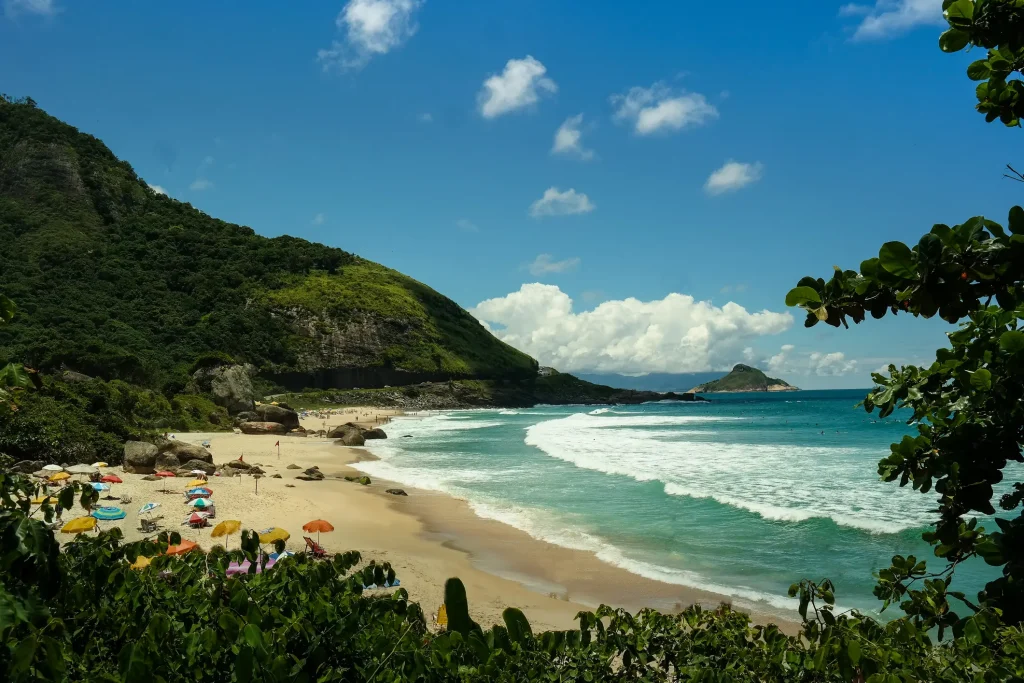
The beach is situated in a cove, creating a natural funnel for the swells, resulting in consistent and reliable surf throughout the year. The beach’s remote location also contributes to its less crowded ambiance compared to other popular surf spots in Rio de Janeiro.
Surrounded by the Atlantic Rainforest, Prainha provides a unique surfing experience, blending the excitement of catching waves with the serenity of the natural surroundings. Surf schools and rental facilities are available for those looking to try their hand at surfing or enhance their skills.
Grumari
Known for its waves and pristine surroundings, Grumari provides a unique surfing experience. The swells at Grumari are particularly favored by experienced surfers, providing a challenge and excitement that aligns with the sport’s true spirit.
The beach is exposed to the open ocean, contributing to the formation of powerful waves that attract surfers seeking an adrenaline-filled ride. Grumari’s relatively uncrowded conditions and natural beauty make it a preferred spot for those looking to escape the bustling crowds often found on other beaches.
Surrounded by lush vegetation and with limited infrastructure, Grumari maintains a more pristine and secluded ambiance, enhancing the overall surfing experience. The combination of challenging waves and the serene natural environment makes Grumari a must-visit destination for surfers looking to test their skills and connect with the raw beauty of Rio de Janeiro’s coastline.
Which beaches in Rio de Janeiro are the safest?
Rio’s beaches, while incredibly inviting, vary in terms of safety. Understanding which beaches offer a safer experience is essential for a worry-free visit, both in terms of police presence and sea conditions, is crucial for a worry-free experience.
Recreio
Situated to the southwest of the city, Recreio stands out for its expansive shoreline and relatively quieter atmosphere compared to some of the more bustling beaches in Rio. What makes Recreio particularly appealing is its reputation for safety.
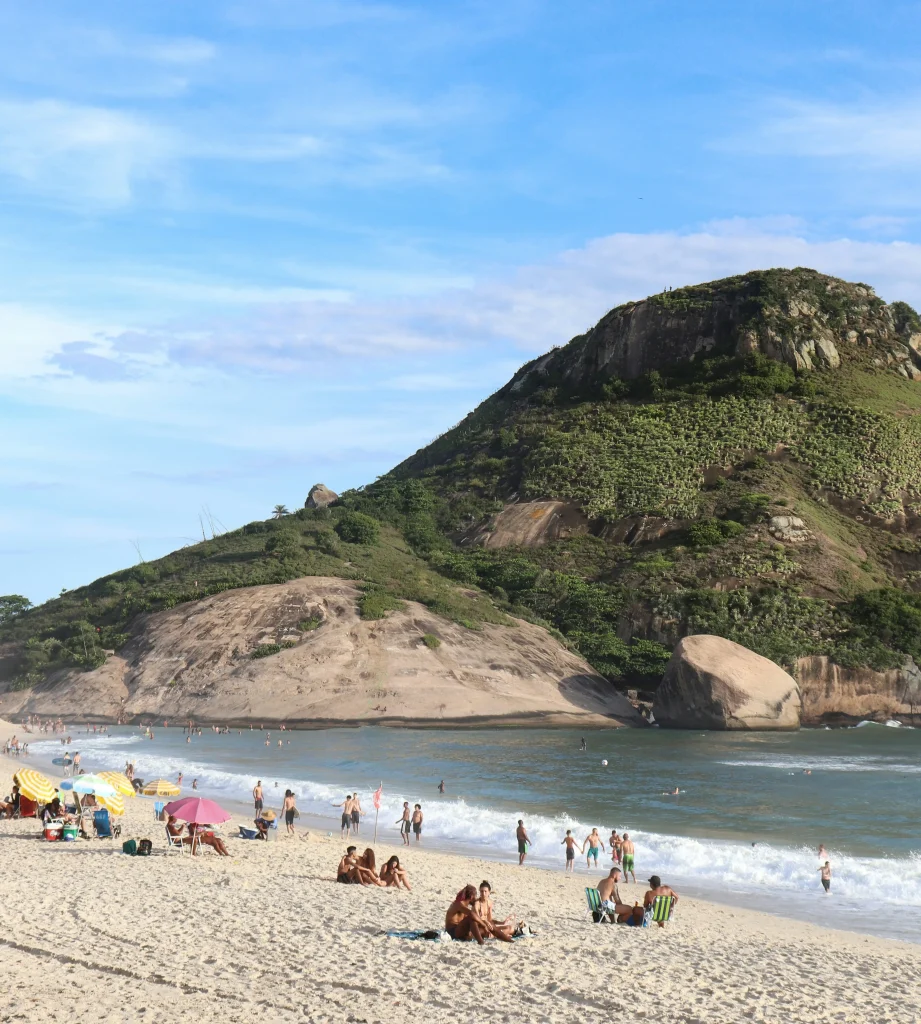
The beach is patrolled by lifeguards, providing a sense of security for visitors. The consistent efforts of local authorities to maintain a safe environment contribute to Recreio’s reputation as a family-friendly destination. Additionally, the surrounding neighborhood has a lower crime rate compared to certain urban areas, enhancing the overall safety of the beachgoers.
Recreio’s strategic location, away from the heart of the city, contributes to a more relaxed and tranquil setting. This makes it an ideal spot for those seeking a peaceful day by the ocean.
Reserva
Reserva Beach excels in providing a secure environment, and is well-known for its vigilant lifeguard presence, ensuring a watchful eye over swimmers and surfers. Additionally, local authorities maintain a strong security presence, contributing to a sense of safety throughout the area.
Reserva is part of a gated community, adding an extra layer of security for those seeking a more controlled and protected beach experience. The controlled access helps regulate the number of visitors, reducing the likelihood of overcrowding and creating a more relaxed atmosphere.
Furthermore, the beach’s well-maintained facilities, including clean restrooms and designated picnic areas, enhance the overall comfort and convenience for visitors. The careful planning and management of Reserva Beach make it not only a visually stunning destination but also a safe and well-regulated space for those looking to enjoy the beauty of Rio de Janeiro’s coastline without compromising on security.
Which beaches in Rio de Janeiro are best for swimming?
When it comes to choosing a beach for swimming, Rio offers a variety of options, each with its own characteristics that cater to different preferences. Factors such as wave intensity, water cleanliness, and safety measures can influence the suitability for swimming.
São Conrado
Situated between the famous neighborhoods of Leblon and Barra da Tijuca, São Conrado is known for its expansive shoreline and relatively calmer waters compared to some of the more bustling beaches in Rio.
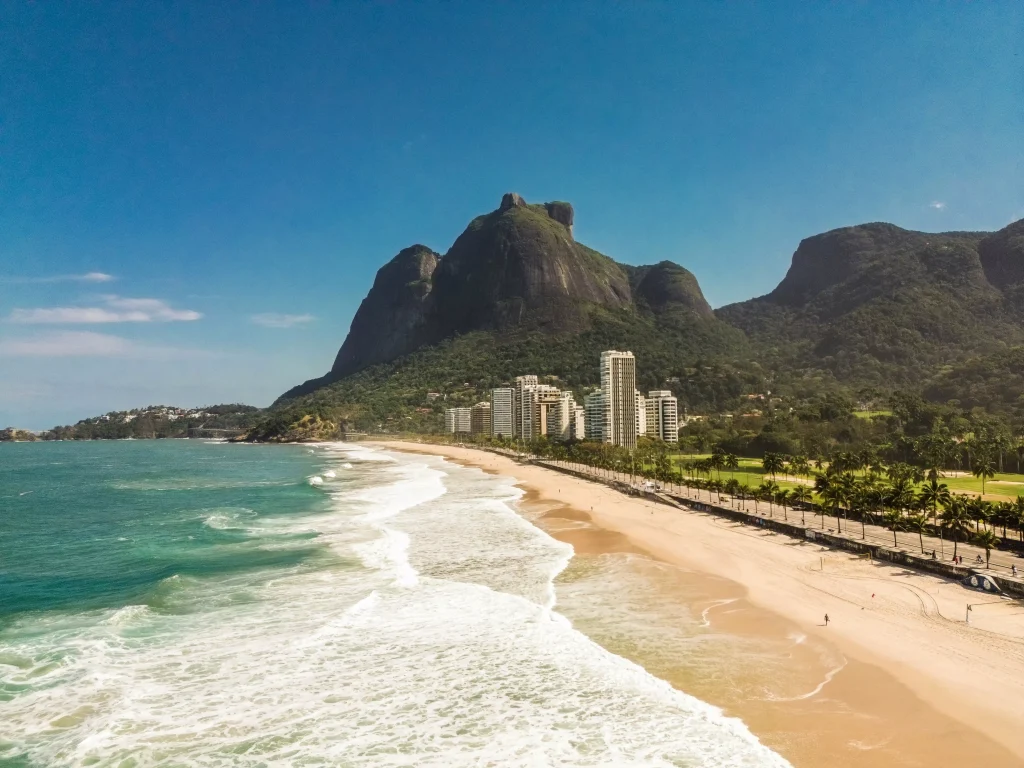
The beach is enclosed by towering cliffs and the lush greenery of Pedra da Gávea, providing a picturesque backdrop. The presence of the Pedra do Pontal rock formations helps create a natural barrier, resulting in gentler waves that are conducive to swimming. This makes São Conrado a preferred spot for those seeking a more relaxed aquatic experience.
In addition to its suitability for swimming, São Conrado attracts visitors with its vibrant local scene, including beachside kiosks offering refreshments and snacks. The overall tranquility and the scenic beauty of São Conrado make it an excellent choice for beachgoers looking to enjoy a serene day by the water.
Secreto
Secreto is a prime location with unique geographical features that contribute to its reputation as an ideal spot for water enthusiasts.
Translated as “Secret Beach,” Secreto lives up to its name by offering a more secluded and serene environment compared to some of the busier beaches in the area. The relatively calm and clear waters create favorable conditions for swimming. The absence of strong currents or tumultuous waves enhances the safety of the beach, making it particularly suitable for those looking to enjoy a leisurely swim.
Furthermore, the beach’s picturesque setting, surrounded by lush greenery and rocky formations, adds to its appeal. While Rio de Janeiro is known for its vibrant atmosphere, Secreto provides a tranquil retreat for individuals seeking a more laid-back and peaceful swimming experience.
Things to do in Rio de Janeiro
In addition to its breathtaking beaches, Rio de Janeiro offers a plethora of activities for visitors to explore. Here are some factual insights into the various things you can do in this vibrant city:
- Christ the Redeemer: A globally recognized symbol of Rio, the Christ the Redeemer statue atop Corcovado Mountain provides panoramic views of the city.
- Sugarloaf Mountain: Take a cable car to the summit of Sugarloaf Mountain for another stunning perspective of Rio and its coastline.
- Tijuca National Park: As one of the largest urban rainforests in the world, it offers hiking trails, waterfalls, and diverse flora and fauna.
- Selarón Steps: Explore the vibrant Selarón Steps, a mosaic masterpiece created by artist Jorge Selarón.
- Museums and Cultural Sites: Rio is home to numerous museums, such as the Museum of Tomorrow and the National Museum, providing insights into Brazil’s rich history and culture.
- Botanical Garden: Established in 1808, the Rio de Janeiro Botanical Garden showcases a vast collection of tropical and subtropical plants.
- Lapa Arches: The historic Carioca Aqueduct, also known as Lapa Arches, is an architectural marvel and a popular spot for nightlife.
- Local Cuisine: Indulge in Brazilian cuisine at local markets or restaurants, trying traditional dishes like feijoada, filé Oswaldo Aranha, and brigadeiro.
Conclusion
Rio de Janeiro’s beaches are notable not only for their aesthetic appeal but also for their diverse offerings. The city’s beach culture is deeply ingrained, attracting locals and tourists alike. It’s important to note that, like any popular destination, the beaches can get crowded, especially during peak seasons, and visitors should be mindful of their belongings and adhere to safety guidelines.
For those looking to explore beyond the well-known stretches of sand, renting a car can be a practical and efficient way to discover the region’s gems! The coastal area surrounding Rio boasts numerous beaches in neighboring towns, each with its own distinct character and charm.







Leave a Reply